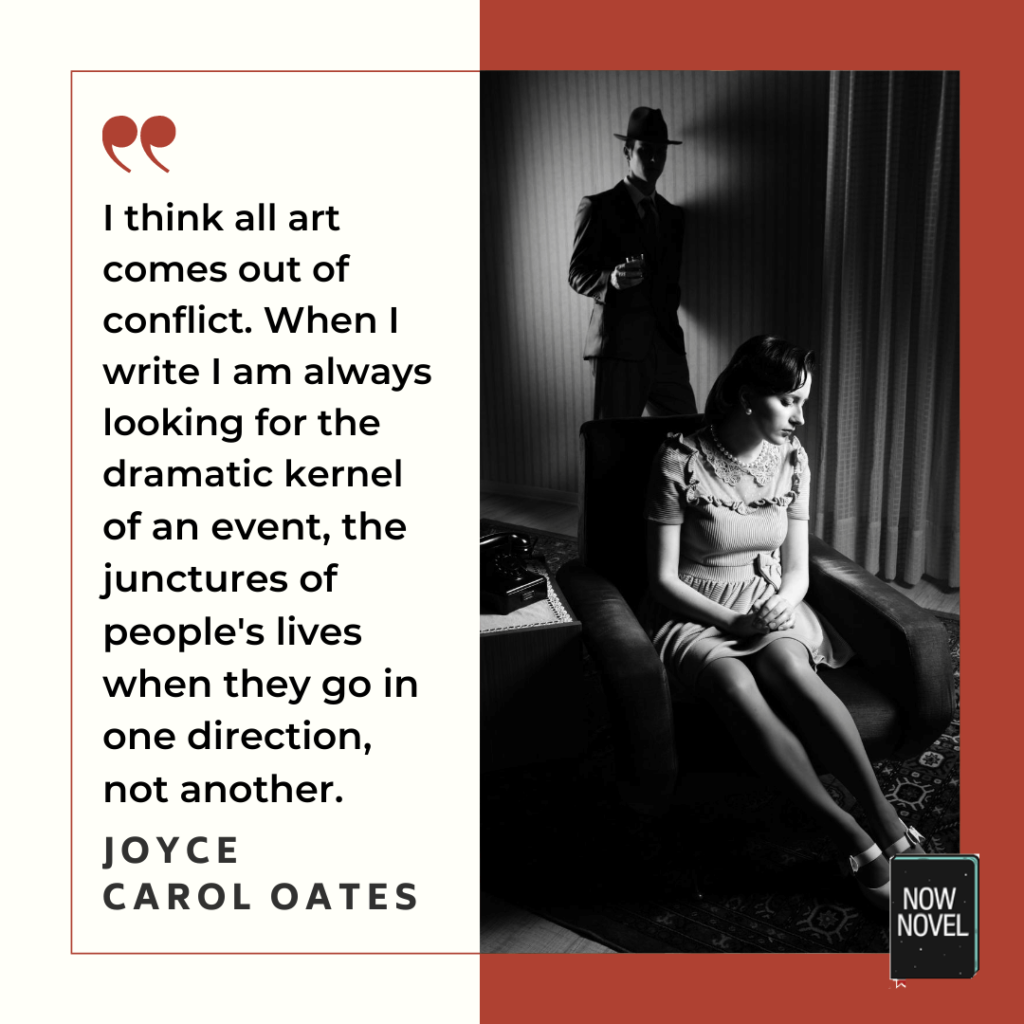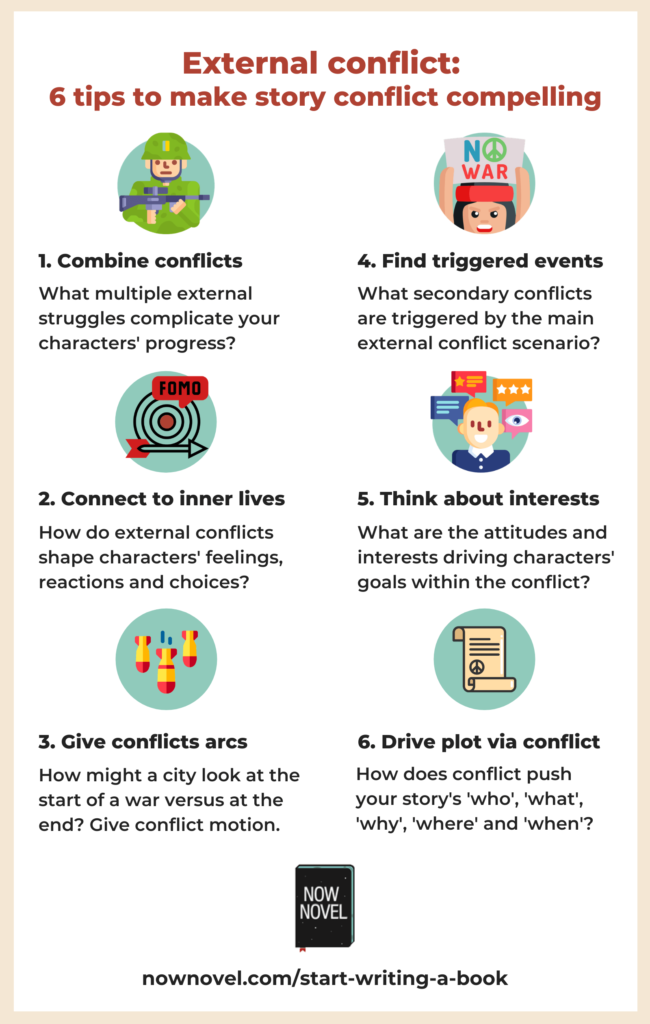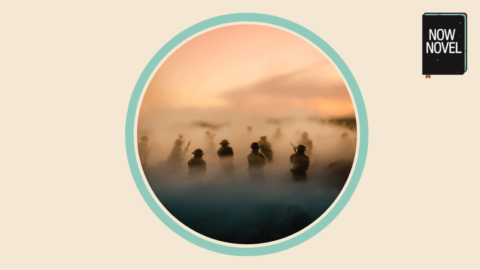External conflict is conflict a character faces that is outside themselves, rather than inner struggle. For example, a sibling rivalry, an oppressive society versus its lone challenger, or the conflict between a town battling for survival and a freak weather event. How do you make external conflict as compelling as the inner struggles your characters face? Here are 6 ideas:
How to make external conflict in stories compelling:
- Combine multiple external conflicts
- Connect external conflicts to characters’ inner lives
- Give external conflicts their own arcs
- Brainstorm other struggles external conflicts trigger
- Think about interests
- Make external conflict drive the story
Let’s dive deeper into this type of conflict:
1. Combine multiple external conflicts
In stories, as in life, struggle often occurs on multiple fronts.
In 2020, a character might face protests stirred up by a political situation, plus the silent, background antagonist of COVID-19, for example.
As an example, in the early pages of Leo Tolstoy’s historical epic War and Peace, Pierre Bezukhov, the illegitimate son of a wealthy count, faces multiple external conflicts:
- A battle for his inheritance: Pierre, though his father’s favourite, faces challenges to inheriting his father’s wealth due to his illegitimacy.
- Uncomfortable marital struggles: Pierre’s friend Prince Andrei meanwhile confesses to Pierre that he has grown to hate his wife and Pierre does not know what to do with this information and the awkward social position this puts him in.
External conflicts create interesting unknowns whose outcome a character doesn’t have complete control over.
It’s only by Book Two of War and Peace, for example, that Pierre inherits and becomes the most eligible bachelor in Russian society, all of a sudden.
Multiple external conflicts create multiple open questions, each requiring an answer/resolution.
2. Connect external conflicts to characters’ inner lives
How interesting is a revolution if we don’t know how its revolutionaries (or their opponents) feel?
A character’s experience of an external, otherwise ‘faceless’ conflict helps us understand, imagine, and empathize. A political fact or statistic becomes relatable, imaginable.
For example, in a story set in a country where LGBTQI relationships are punishable by death, external conflict (between a character and their society) will obviously shape their private struggles, fears and decisions.
Will they react to their situation with anger? Defiance? Submission?
External conflicts enable scenarios to show who people are. And, through their reactions and decisions, who they’re becoming.

3. Give external conflicts their own arcs
Think about the timeline of the main external conflict in your story.
Whether it’s a rivalry between showmen, or the path of a hurricane, where does the external conflict grow more intense, and where does it become a simmering source of tension in the background?
As an example, in Evelyn Waugh’s classic novel Brideshead Revisited, a primary external conflict – World War Two – changes a setting important to the story’s protagonist, Charles Ryder.
In the prologue, Ryder and his battalion, during the final years of World War Two, are sent to a country estate named Brideshead. This triggers Ryder’s memories of visting Brideshead many years before, in the 1920s.
At the end of the book we see how war has completely changed the estate, and this has a poignant effect after all the memories we’ve seen through Ryder’s eyes.
In brainstorming her own novel using the Now Novel process, coach and writer Arja Salafranca discovered that part of the conflict affecting her characters had to do with the fact that they needed to avoid scandal.
In light of this, think about how your story’s external conflict could:
- Change the appearance, mood, state of repair or decay of a place (the way World War Two changes a once-grand country estate to crumbling military post in Brideshead, for example, which creates a melancholic mood of loss)
- Peak or intensify at key moments (at what point in the story might the external conflict become the most intense? How does this affect characters’ lives?)
4. Brainstorm other struggles external conflicts trigger
One of the darker aspects of conflict is that it tends to beget more conflict.
For example, in a civil war, a resident of a town might sell out supporters of the opposing side, placing them in danger.
As an exercise, write down an external conflict idea. For example:
‘A woman runs for the presidency in a country where a tyrant has just banned all opposition.’
Now brainstorm secondary external conflicts that could arise in this situation. For example:
- The woman’s cousin, supportive of the regime, rats her out, sharing her hiding place
- The woman and her husband (who is more moderate and politically disengaged) fight about her commitment to her cause
- Kids at school whose parents are supporters of the regime pick fights with her children
Secondary conflicts linked to a primary external conflict have many uses.
They:
- Supply extra narrative suspense by creating more conflict situations
- May show the destructive effects of the main conflict through exemplary related incidents
- Add additional stakes (for example, now the revolutionary woman’s marriage is at stake, in addition to her political liberty)

5. Think about interests
‘Human’ conflicts differ from natural ones in that they have ‘interests’.
A hurricane doesn’t care whether it tears the roof off your house. It does not have an interest, a goal or object underlying its actions.
Human conflict, on the other hand, involves ‘interest’. R.J. Rummel writes about the connection of interest to power and conflict:
Now, an interest as an activated attitude always involves a goal and object: a person has an interest in helping others, in getting a B.A. degree, in going to a movie, and so on. Moreover, interests consist of an active tendency, a strength towards the realization of their goals and thus the gratification of their desires.
R.J. Rummel, in UNDERSTANDING CONFLICT AND WAR: VOL. 2: THE CONFLICT HELIX, available here.
When thinking about human external conflicts in your story, factoring in interest – an ‘activated attitude’ that ‘involves a goal and an object’ – will help you make conflict contribute meaningfully to your plot.
For example, Prince Andrei has an interest in serving in the war in War and Peace. You could say this ‘attitude’ is ‘activated’ in part by his wish to escape the marriage that he finds unfulfilling.
The conflict prompts an action, which in turn involves Andrei in a new conflict (he goes to war, leaving behind his pregnant wife, and is badly wounded in the Battle of Austerlitz).
6. Make external conflict drive the story
Whether your external conflict is a natural disaster, a squabble between spouses or a standoff of another type, a compelling external conflict drives action and plot.
For example, Prince Andrei’s conflict in his marriage in War and Peace causes him to seek out an even bigger, more dire one.
As you write, think about how external conflict dives the ‘5 W’s’ of your story: ‘who, what, why, where and when’. Who is involved? Why? Where does the conflict go down, and when? And – most importantly – what happens as a result?
Start finding compelling conflicts and developing them into structured scene summaries in Now Novel’s story dashboard.

